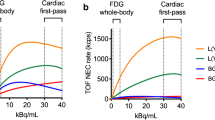Abstract
Background: The radial long-axis orientation for the measurement of left ventricular (LV) volume and mass has been shown to have advantages over the short-axis orientation. Previous work has highlighted the need for technique specific normal ranges. The purpose of this study was therefore to establish normal ranges of LV volume and mass for the radial long-axis orientation. Materials and methods: Forty normal subjects (20 males, average age 32.3, age range 19–58; 20 females, average age 37.4, age range 21–54) were examined utilising a steady state free precession (SSFP) pulse sequence. Two observers analysed the images independently using in-house validated software. Results: The normal ranges for LV end-diastolic volume measurements after adjustment to body surface area (BSA) were 62–120 ml for males and 58–103 ml for females. LV mass indexed to BSA ranged from 50–86 g for males and 36–72 g for females. The normal range for ejection fraction was 49–73 % for males and 54–73 % for females. Conclusion: A gender specific normal range using SSFP in the radial long-axis orientation was established.
Similar content being viewed by others
References
Missouris CG, Forbat SM, Singer DR, Markandu ND, Underwood R, MacGregor GA (1996) Echocardiography overestimates left ventricular mass: a comparative study with magnetic resonance imaging in patients with hypertension. J Hypertens 14(8):1005–1010
Verdecchia P, Scillaci G, Borgioni C, Ciucci A, Gattobigio R, Zampi I, Reboldi G, Porcellati C (1998) Prognostic significance of serial changes in left ventricular mass in essential hypertension. Circulation 97:48–54
Dahlof B, Devereux RB, Kjeldsen SE, Julius S, Beevers G, Faire U, Fyhrquist F, Ibsen H, Kristiansson K, Lederballe-Pederson O, Lindholm LH, Nieminen MS, Omvik P, Oparil S, Wedel H (2002) The LSG. Cardiovascular morbidity and mortality in the Losartan intervention for endpoint reduction in hypertension study (LIFE): a randomised trial against atenolol. (comment, summary for patients. J Fam Pract; 51(7):599; PMID: 12160492). Lancet 359:995–1003
St John Sutton M, Otterstat JE, Plappert T, Parker a, Sekarski D, Keane MG, Poole-Wilson P, Lubsen K (1998) Quantification of left ventricular volumes and ejection fraction in post-infarction patients from biplane and single plane two-dimensional echocardiograms A prospective longitudinal study of 371 patients. Eur Heart J 19:808–816
Hibberd MG, Chuang ML, Bleaudin RA, Riley MF, Mooney MG, Fearnside JT, Manning WJ, Douglas PS (2000) Accuracy of three-dimensional echocardiography with unrestricted selection of imaging planes for measurement of left ventricular volumes and ejection fraction. Am Heart J 140:469–475
Buck T, Hunold P, Wentz KU, Tkalec W, Nesser HJ, Erbel R (1997) Tomographic three-dimensional echocardiographic determination of chamber size and systolic function in patients with left ventricular aneurysm: comparison to magnetic resonance imaging, cineventriculography, and two-dimensional echocardiography. Circulation 96:4286–4297
Salcedo EE, Gockowski K, Tarazi RC (1979) Comparison of M Mode and two-dimensional echocardiography in two experimental models. Am J Cardiol 4:936–940
Alfakih K, Thiele H, Plein S, Bainbridge GJ, Ridgway J, Sinvananthan UM (2002) Comparison of right ventricular volume measurement between segmented k-space gradient-echo and steady state free precession magnetic resonance imaging. J Magn Reson 16:253–258
Aebischer N, Meuli R, Jeanrenaud X, Koerfer J, Kappenberger L (1998) An echocardiographic and magnetic resonance imaging comparative study of right ventricular volume determination. Int J Cardiac Imaging 14:271–278
Bloomer T, Plein S, Radjenovic A, Higgins DM, Jones TR, Ridgway JP, Sinvananthan UM (2001) Cine MRI using steady state free precession in the radial long axis orientation is a fast accurate method for obtaining volumetric data of the left ventricle. J Magn Reson 14:685–692
Marcus JT, Gotte MJ, DeWaal LK, Stam MR, Van der Geest RJ, Heethaar RM (1999) The influence of through-plane motion on left ventricular volumes measured by magnetic resonance imaging: implications for image acquisition and analysis. J Cardiovasc Magn Reson 1(1):1–6
Bloomgarden DC, Fayad ZA, Ferrari VA, Chin B, St. John Sutton MG, Axel L (1997) Global cardiac function using fast breath-hold MRI: Validation of new acquisition and analysis techniques. MRM 37:683–692
Bland JM (1995) An introduction to medical statistics. Oxford Medical publications, Oxford, pp 266–273
Alfakih K, Plein S, Thiele H, Jones T, Ridgway J, Sinvananthan MU (2003) Normal human left and right ventricular dimensions for MRI as assessed by turbo gradient echo and steady-state free precession imaging sequences. J Magn Reson 17:323–329
Lorenz CH, Walker ES, Morgan VL, Klein SS, Graham TP (1999) Normal human right and left ventricular mass, systolic function, and gender differences by cine magnetic resonance imaging. J Cardiovasc Magn Reson 1(1):7–21
Marcus JT, DeWaal LK, Gotte MJ, Van der Geest RJ, Heethaar RM, Van Rossum AC (1999) MRI-derived left ventricular function parameters and mass in healthy young adults: relation with gender and body size. Int J Cardiac Imaging 15:411–419
Author information
Authors and Affiliations
Corresponding author
Rights and permissions
About this article
Cite this article
Clay, S., Alfakih, K., Radjenovic, A. et al. Normal Range of Human Left Ventricular Volumes and Mass Using Steady State Free Precession MRI in the Radial Long Axis Orientation. Magn Reson Mater Phy 19, 41–45 (2006). https://doi.org/10.1007/s10334-005-0025-8
Received:
Accepted:
Published:
Issue Date:
DOI: https://doi.org/10.1007/s10334-005-0025-8




